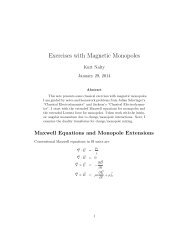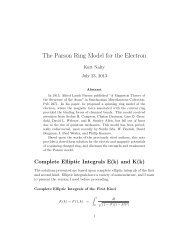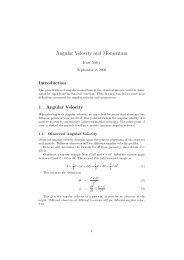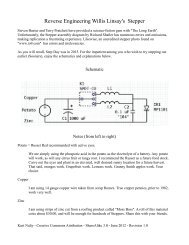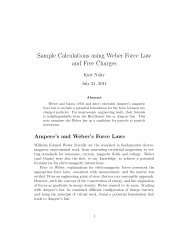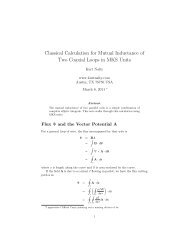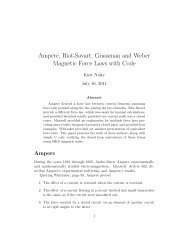The Illusion of Time's Arrow - Kurt Nalty
The Illusion of Time's Arrow - Kurt Nalty
The Illusion of Time's Arrow - Kurt Nalty
Create successful ePaper yourself
Turn your PDF publications into a flip-book with our unique Google optimized e-Paper software.
<strong>The</strong> <strong>Illusion</strong> <strong>of</strong> Time’s <strong>Arrow</strong><br />
<strong>Kurt</strong> <strong>Nalty</strong><br />
January 19, 2007<br />
Abstract<br />
Parameterization <strong>of</strong> physics using time in a four dimensional spacetime<br />
is capricious, and leads to infinities in mathematics. <strong>The</strong> four dimensional<br />
pathlength s is a better choice. Such a description allows resolution <strong>of</strong><br />
paradoxes such as electron pre-acceleration during radiation, and helps<br />
provide a plausible basis for quantum mechanical phenomonea, such as<br />
the uncertainty principle and virtual particles.<br />
Drift Velocity and the Time as a River Analogy<br />
Before dealing with four dimensional spacetime, I wish to look at coordinates<br />
and drift motion in regular experience.<br />
Imagine a small boy on a boat, dragging a fishing bob in a circular path.<br />
When the boat is stationary, there is no debate that the x and y components<br />
<strong>of</strong> motion <strong>of</strong> the fishing bob go both positive and negative. Displacement is<br />
clearly bipolar. However, as the boat begins to move faster and faster (say in<br />
the x direction), while the y displacement remains bipolar, the drift velocity in<br />
the x direction can easily overwhelm the oscillator component, leading to the<br />
situation that x always increases, although the rate <strong>of</strong> increase may vary.<br />
14<br />
12<br />
10<br />
8<br />
6<br />
4<br />
2<br />
0<br />
-2<br />
-15 -10 -5 0 5 10 15<br />
Circular Motion without Drift<br />
Circular Motion with Small Drift<br />
Circular Motion with More Drift<br />
Circular Motion with Large Drift<br />
Circular Motion with Very Large Drift<br />
1
Our experience with space time is analogous to the boy on a fast flowing<br />
river. Our ’velocity’ has components <strong>of</strong> motion, where the time component <strong>of</strong><br />
velocity is so high that our usual experience has time always increasing.<br />
Describe the coordinates <strong>of</strong> a point in spacetime by ˜r = (t, x, y, z). <strong>The</strong><br />
change in this coordinate is d˜r = (dt, dx, dy, dz). <strong>The</strong> magnitude <strong>of</strong> the change<br />
(+ sign choice) is ds = |d˜r| = √ dt 2 + dx 2 + dy 2 + dz 2 .<br />
When we look at the four dimensional unit (tangent) vector, we have<br />
ũ = d˜r<br />
ds<br />
(dt, dx, dy, dz)<br />
= √<br />
dt2 + dx 2 + dy 2 + dz 2<br />
=<br />
=<br />
(1, dx/dt, dy/dt, dz/dt)<br />
√<br />
1 + ( )<br />
dx 2<br />
( ) 2<br />
dt + dy<br />
(<br />
dt + dz<br />
dt<br />
1, ⃗v<br />
√<br />
1 + v<br />
2<br />
) 2<br />
It is now customary in physics to measure time in meters using the speed <strong>of</strong><br />
light as a conversion factor. (Using this convention, the speed <strong>of</strong> light becomes<br />
1.)<br />
From COBE data (find references and most accurate number), we know that<br />
earth has a relative velocity <strong>of</strong> 371 km/sec to the cosmic radiation background.<br />
While this number seems impressive, if we express this velocity as a fraction<br />
<strong>of</strong> the speed <strong>of</strong> light, we find that our speed is only 0.00124c. If we measure<br />
time and space in the same units (for example, meters), the four dimensional<br />
cartesian unit tangent will have components <strong>of</strong><br />
(<br />
)<br />
1<br />
ũ = √ , ⃗v<br />
√ = (0.999999235, 0.00124) (1)<br />
1 + v<br />
2 1 + v<br />
2<br />
Simply put, our velocity in the time direction is just barely under the speed<br />
<strong>of</strong> light. It is this high velocity in the time direction that gives time it’s special<br />
status, from our point <strong>of</strong> view <strong>of</strong> choice <strong>of</strong> coordinates.<br />
Our situation with respect to time is analogous to that <strong>of</strong> a particle directly<br />
approaching the event horizon <strong>of</strong> a black hole in conventional spacetime. As the<br />
particle falls, the radial speed increases such that just before the event horizon,<br />
the radial speed is just about the speed <strong>of</strong> light, and the transverse speed components<br />
are insignificant. For this particle, there is clearly a difference between<br />
the radial and non-radial directions. This particle may prefer to parameterize<br />
its events using radial position as an always increasing parameter, and could do<br />
so fairly accurately.<br />
Poor Choice <strong>of</strong> Parameterization Leads to Infinities<br />
Return to the example <strong>of</strong> circular motion imposed upon a drift velocity. For the<br />
case where the motion is parameterized by the x component, when the x velocity<br />
changes direction, tangential infinities will occur. For a contrived example, let<br />
y = sin(t) and x = v ∗ t + cos(t).<br />
2
dx = (v − sin(t))dt<br />
dy = cos(t)dt<br />
dy<br />
dx = cos(t)<br />
v − sin(t)<br />
When v





